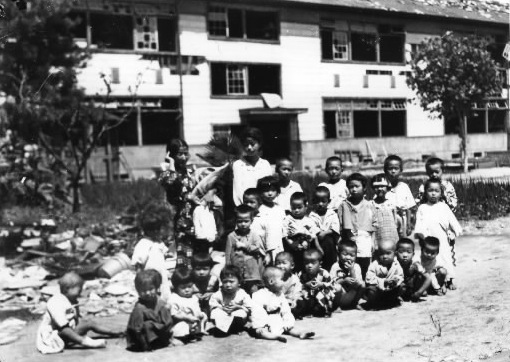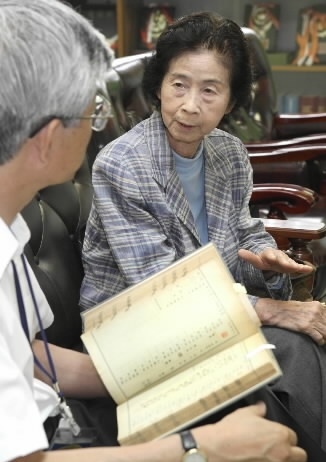Images of the Atomic Bombing, 1945~2007, Part 4
Jun. 27, 2010
"Mother's love" given to orphans
by Masami Nishimoto, Senior Staff Writer
What were the consequences of the atomic bombing of Hiroshima? What consequences continue to linger on? This series [originally published in August 2007] traces the people linked to photographs which record the A-bomb devastation. With some voices in Japan now contending that the nation should arm itself with nuclear weapons, it is time to stress the reality of the destruction these weapons wreak.
Diary records days of chaos
This photo was taken at the "Orphans' Home" which the city of Hiroshima set up on August 8, 1945 at Hijiyama National School, now Hijiyama Elementary School, in Minami Ward. The facility took in young children whose parents had gone missing. Judging from the flannel clothes the subjects are wearing and the damaged school building, the image is believed to have been taken around October. The photographer was Toshio Kawamoto, a Hiroshima Prefectural Police photographer who died in 1968 at the age of 66. After his death, family members found the photo in Mr. Kawamoto's studio in 1971. This is the only existing image that testifies to the existence of this facility. Along with the children can be seen teachers of the school. In the chaos of post-war Japan, the teachers became "mothers" for the orphans.
Yasuko Tanimura, 81, a resident of Higashi Ward, Hiroshima, grew tearful when she saw, for the first time, the photo taken in front of the school building with its empty window frames, absent the panes of glass shattered by the blast. In the center of the photo stands Ms. Tanimura, then 19. To her left is Yoshie Tomasu in her bulky work pants. Ms. Tomasu died in 1991 at the age of 76. Both women were teachers at Hijiyama National School. At the "Orphans' Home" that opened in their school building, which had escaped the fires of the city, they devoted themselves to the care of young orphans.
A school diary for 1945 that has been preserved at Hijiyama Elementary School describes the overwhelming turmoil of that time. The following are a few entries from the diary, written in ink:
August 6: A powerful bomb has injured about 30 children, some lightly and others seriously.
August 8: At 4 p.m. a city official brought a group of orphans to the school. The "Orphans' Home" has opened.
August 9: Many people are still groaning in pain from the injuries they suffered in the bombing. The number of orphans has grown to 24.
In a section of the diary that recorded attendance, the names of four female teachers can be found, including Ms. Tanimura. They were living in the school's sick room with the children. Most of the other teachers were away, having been evacuated from the city before the bombing along with the schoolchildren who were in grades 3 and above. Some teachers, too, were exposed to the bomb's heat rays near Sumiyoshi Bridge while carrying supplies that were bound for the evacuation sites.
"I was young so I was just following the direction given to me by the older teachers," Ms. Tanimura said, praising those teachers for their efforts. One teacher who had a baby of her own breastfed the orphaned infants, and others who lived near the school drew baths and bathed the children. They also gave names to the children whose names were not known. Everyone became a "mother" to the orphans and Ms. Tanimura shyly admitted that she, too, offered her breast to the babies.
The diary entry for August 15 states that "Rations were distributed to us." However, the emperor's radio broadcast that announced the end of the war that day was not mentioned. The teachers were presumably too preoccupied to write detailed notes.
The entry for August 18 indicates that "A nursing teacher has arrived." This suggests that the city had begun to provide assistance to the "Orphans' Home."
As Ms. Tanimura reflected on that time, a memory that had not been recorded in the diary returned to her vividly: "We had to pull a cart through the debris toward City Hall to collect supplies."
The sandbox in the school yard became a makeshift crematorium. The teachers piled up firewood and burned the bodies of the small children who passed away from their exposure to the atomic bomb. The principal then retrieved the ashes. In "The Record of the Hiroshima A-bomb Disaster," published in 1971, Ms. Tomasu wrote that at least 11 people were cremated there.
It is said that the "Orphans' Home" took in a total of roughly 200 children. The children whose parents never appeared were then relocated to the Hiroshima War Orphans Foster Home, which was established toward the end of that year.
Ms. Tanimura retired as a teacher in 1982. In teaching "peace education" to her students, a subject of study that arose in the 1970s, she asked them to listen to the wartime experiences of their grandparents. However, she never shared her own account with them. It was apparently too close, too painful, to broach.
On the morning of August 6, when the bomb exploded, she was at the school. Late that evening she made her way back to her home in Higashi Ward to find that her father Hideo, then 44, had not returned. He worked at the head office of the Hiroshima City Credit Association. Ms. Tanimura was the oldest daughter of four children. While worrying over her father's fate, she was summoned back to school to care for the orphans. She was unable to even search for her father's remains.
"I detest war," she said. "I never want there to be another war." This has been her hope since the days she held those small orphans in her arms.
(Originally published on August 12, 2007)









